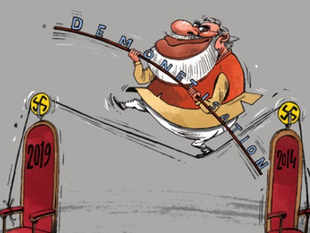View: What was PM Modi’s political calculation in launching this radical exercise?
By Raghavan Jagannathan
In electoral democracies, all major economic decisions have a political dimension. The Narendra Modi government’s decision to demonetise high-value currency notes is nothing if not political.It has a fuzzy economic component (financial inclusion and digitisation of payments), a stated end goal (reduction of black money), and an unstated political ambition (repositioning of Modi and his party before 2019).
Demonetisation would not make sense without understanding the political component in the decision.Reason: no politician would willingly risk growth and jobs if he did not think there would be political gains at the end of the rainbow, especially when the pain is upfront.
The consensus is that the cash crunch will last till the next quarter (January-March 2017). GDP growth will be adversely impacted for at least two quarters as small businesses and traders lose out in the cash compression that followed the elimination of 85% of currency outstanding with the public.
Whether it is a 2% GDP growth loss, as Manmohan Singh said the other day, or just half a percent as optimists hope, a deceleration is unavoidable. It is unlikely that Modi did not know how this would affect the economy, even assuming he consulted no one about demonetisation. When a politician willingly sacrifices short-term growth, he must be seeing a medium term pot of political gold somewhere.
Only the prime minister can answer what his calculations were, but from the outside this is what the political gamble seems to be about. Modi has never hidden his desire to be a two-term prime minister, and all his actions must be seen as relevant to ensuring he gets another shot at office in 2019.
While no one can predict which issues will dominate the 2019 campaign, it is interesting that two of his major initiatives the surgical strikes against terror camps and the demonetisation shock come just when he is mid-way in his first term. On November 26 Modi completed two-and-a-half years in office, and this means he has to come to a conclusion on whether he has achieved enough or, rather, he is perceived to have achieved enough to give him a shot at 2019. The demonetisation initiative suggests that he has concluded he must be seen to have done more. Hence the willingness to take a huge risk with short-term growth.
If one were to look at Modi’s legislative and other achievements, the laundry list is truly impressive. Inflation is under control and central finances in good shape. The insurance, coal and minerals bills have been passed and successful auctions held. A bankruptcy code has been adopted. Aadhaar is now backed by law, and subsidy reforms are well underway , with cooking gas already shifting to direct benefit transfer (DBT). Power and coal sector problems have been fixed (at least temporarily) and infrastructure investment has begun in roads and railways. Some 25 crore Jan Dhan accounts have taken financial inclusion farthest in India’s history.
Why would someone with this scale of achievement want to risk it all by gambling on growth and inflicting huge inconveniences on ordinary folks in the name of going after black money? Why would he want to alienate his own core constituencies the trading community which is worst hit by demonetisation and the urban middle classes in the hope of gaining more elsewhere?
Elections are won not by legislative achievements and reforms, but when voters see the gains for themselves. In 2009, the legislative record of UPA was hardly anything to write home about and reforms were stalled on many fronts. But UPA won a bigger mandate because the economy was firing on all cylinders and people had experienced some of the benefits of high growth.
In 2004, after four years of huffing and puffing, Vajpayee’s government saw growth rebound spectacularly only in its final year (2003-04). But people hadn’t begun to feel the difference.People felt the improvement in UPA-I, and they got the electoral benefit; NDA-I’s better record of reforms went unsung.
Modi does not want to face the same fate as Vajpayee, and this is one reason why he may be willing to court more risks in a bid to retain power in 2019.
Consider the economy’s track record under Modi: while growth has revived, the 7% plus growth does not seem like 7%. This is evidenced by weak underlying indicators, including low capital investment, overleveraged corporate balance-sheets, a spike in bank bad loans, and a collapse in exports. Most important, the rising GDP numbers are nowhere reflected in new jobs created.
This is the context in which Modi probably believes he needs to do more. The calculation may run thus: if demonetisation results in large amounts of Rs 500 and Rs 1,000 notes remaining outside the system, RBI can write down those liabilities and pay the government a higher dividend, perhaps as much as Rs 1.5-2 lakh crore. Then there will be gains in terms of lower interest rates (already happening) and higher tax revenues as undisclosed incomes now come to the taxman’s notice.
A Rs 3 lakh crore additional kitty in 2017 would be just what Modi needs to recapitalise banks, give every Jan Dhan account holder a cash payment (which will be touted as money extracted from black money holders), lower taxes and increase investments in growth-enhancing infrastructure.The gains may look higher than the losses to him politically. Who knows, it just may pay off electorally by 2019, if not in UP in 2017.
___
http://economictimes.indiatimes.com/articleshow/55661355.cms
